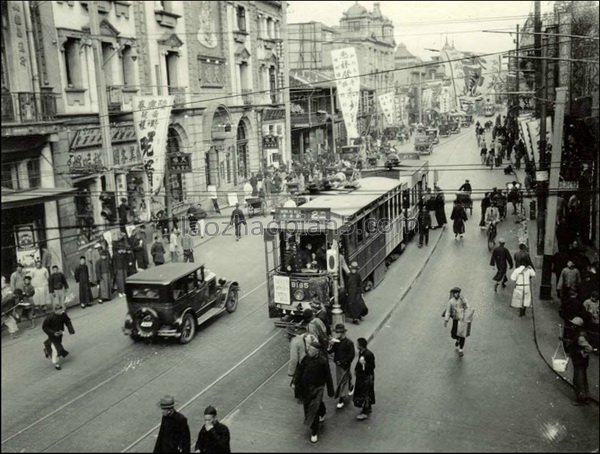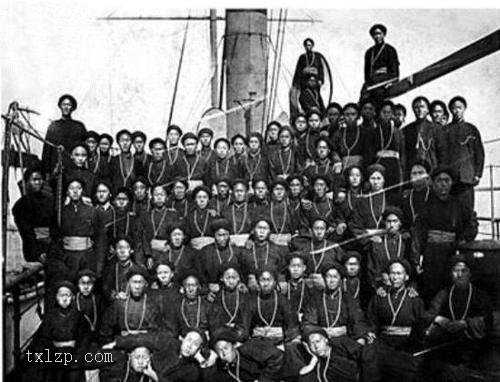Period:Tang dynasty Production date:8thC-9thC
Materials:stucco, 灰泥 (Chinese),
Technique:mould-made, painted, 模製 (Chinese),
Subjects:bodhisattva 菩薩 (Chinese)
Dimensions:Height: 30 centimetres
Description:
Fragment of a statue made of stucco. This is the head of a Bodhisattva with a curly moustache. The hair is parted from the centre and fastened in a fan-shaped topknot. The Bodhisattva wears an elaborate crown, consisting of a beaded tiara which supports three plaques that are decorated with formalised floral motifs. Traces of pigments make clear that the face was originally painted white, the hair blue and the eyebrows, pupils as well as the moustache black. The crown has red and green details.
IMG
![图片[1]-figure; 畫像(Chinese) BM-MAS.1102-China Archive](https://chinaarchive.net/Tang dynasty/43/mid_00012984_001.jpg)
![图片[2]-figure; 畫像(Chinese) BM-MAS.1102-China Archive](https://chinaarchive.net/Tang dynasty/43/mid_00322700_001.jpg)
Comments:EnglishFrom Whitfield 1985:Several features distinguish this large head from the pieces shown in the previous two plates and from the large head of Pl. 103. Not only is the colouring well preserved, but the form and style of the head are quite different. The general outline of the face is squarish and the flesh is rather heavy, reflecting Chinese influence. The eyes are the most noticeable feature, with their complex double curvature. Beneath the three-pronged crown, the hair is parted in the centre and drawn in overlapping waves to the sides, in a fashion far removed from the classical locks bound with a fillet seen in the majority of the heads.Also from the same building, xviii, is the large fragment of the arm of a Lokapala or similar guardian figure, clad in armour, and with a fierce monster head at the shoulder (Fig. 145); likewise the semicircular pedestal base-actually the front half of a circular base-decorated in low relief with a vase and acanthus leaves (Fig. 156); and another large fragment, the bent knee of a life-size seated Bodhisattva, with most of the original striking crimson, maroon and blue colouring intact (Fig. 157). The image base, still intact and showing some of the identical decoration as the other half, can be seen in two of Stein’s photographs of the ruined shrine (Serindia, Vol.Ⅲ, Figs. 289-90). Next to the pedestal is another life-size seated Bodhisattva on a lotus seat, with a large part of the man-dorla still intact. The Bodhisattva’s head is missing, and Stein was unable to remove the figure because of its weight. In his description, however, he mentioned the richly embroidered garments with floral designs, recalling the workmanship of Chinese figured silks. In the antechapel there was still a fragment of a wall painting (Mi. xviii. 004; Serindia, Vol. Ⅳ, Pl. CXXVI), with Uighur donors and inscriptions below and part of a scene showing the bare legs of a man knee-deep in a pool, accompanied by a dragon. From this fragment of a wall painting, as well as from the style of the large fragments of stucco figures, it is possible to contrast eighth- and ninth-century Ming- oi art with the earlier reliefs found in such abundance by Stein and others at the site. ChineseFrom Whitfield 1985:此大型菩薩頭部與上兩圖的天部、菩薩頭部及圖103的大型佛頭有許多不同的特點。不僅色彩保留較好,形態和風格也完全不同。面部輪廓爲方形,膚色稍顯厚重,反映了很深的中國影響。最爲引人注目的是眼睛的表現,半睜的眼瞼有微妙的曲線。三山冠下的頭髮中分,稍作重疊,梳向後面。此髮型多見於菩薩頭部,遠離了用彩帶纏繞髮髻的古典模式。在同一寺址(xviii)還發現了著鎧甲、肩托兇猛怪物頭,大概是天王像的單臂(Fig. 145),以及壺、莨苕葉淺浮雕的半圓形台座――實際上是圓形台的前半部分(Fig. 156),正紅、栗色、青色等當時鮮豔的色彩幾乎是原封不動地保留在菩薩坐像的彎膝部分(Fig. 157)等。斯坦因拍攝的此廢寺的兩張照片,可見到此室對面,相同裝飾的壇基完整的面貌(參照《西域》第3卷,Figs. 289-90)。連接那台座的有另一與真人等身的菩薩像,其坐在蓮華座上,曼陀羅的大部分還完整地保留著。菩薩的頭部雖已殘失,但仍很重,斯坦因無法移動。根據斯坦因的記錄,此像的穿著讓人想起中國織錦技術的華麗花紋的刺繡外衣。其前室裏還殘留著壁畫斷片(參照Mi.xviii.004,《西域》第4卷,圖版CXXVI)。此壁畫的下段有回鶻供養人像和回鶻文題記,上段有水淹及男子赤裸的膝蓋以下及身旁的龍。根據此壁畫斷片以及塑像殘片的風格,可以嘗試對8~9世紀的明屋美術和斯坦因及其他人從此遺迹發現的更早時期的大量浮雕類作品進行比較研究。
Materials:stucco, 灰泥 (Chinese),
Technique:mould-made, painted, 模製 (Chinese),
Subjects:bodhisattva 菩薩 (Chinese)
Dimensions:Height: 30 centimetres
Description:
Fragment of a statue made of stucco. This is the head of a Bodhisattva with a curly moustache. The hair is parted from the centre and fastened in a fan-shaped topknot. The Bodhisattva wears an elaborate crown, consisting of a beaded tiara which supports three plaques that are decorated with formalised floral motifs. Traces of pigments make clear that the face was originally painted white, the hair blue and the eyebrows, pupils as well as the moustache black. The crown has red and green details.
IMG
![图片[1]-figure; 畫像(Chinese) BM-MAS.1102-China Archive](https://chinaarchive.net/Tang dynasty/43/mid_00012984_001.jpg)
![图片[2]-figure; 畫像(Chinese) BM-MAS.1102-China Archive](https://chinaarchive.net/Tang dynasty/43/mid_00322700_001.jpg)
Comments:EnglishFrom Whitfield 1985:Several features distinguish this large head from the pieces shown in the previous two plates and from the large head of Pl. 103. Not only is the colouring well preserved, but the form and style of the head are quite different. The general outline of the face is squarish and the flesh is rather heavy, reflecting Chinese influence. The eyes are the most noticeable feature, with their complex double curvature. Beneath the three-pronged crown, the hair is parted in the centre and drawn in overlapping waves to the sides, in a fashion far removed from the classical locks bound with a fillet seen in the majority of the heads.Also from the same building, xviii, is the large fragment of the arm of a Lokapala or similar guardian figure, clad in armour, and with a fierce monster head at the shoulder (Fig. 145); likewise the semicircular pedestal base-actually the front half of a circular base-decorated in low relief with a vase and acanthus leaves (Fig. 156); and another large fragment, the bent knee of a life-size seated Bodhisattva, with most of the original striking crimson, maroon and blue colouring intact (Fig. 157). The image base, still intact and showing some of the identical decoration as the other half, can be seen in two of Stein’s photographs of the ruined shrine (Serindia, Vol.Ⅲ, Figs. 289-90). Next to the pedestal is another life-size seated Bodhisattva on a lotus seat, with a large part of the man-dorla still intact. The Bodhisattva’s head is missing, and Stein was unable to remove the figure because of its weight. In his description, however, he mentioned the richly embroidered garments with floral designs, recalling the workmanship of Chinese figured silks. In the antechapel there was still a fragment of a wall painting (Mi. xviii. 004; Serindia, Vol. Ⅳ, Pl. CXXVI), with Uighur donors and inscriptions below and part of a scene showing the bare legs of a man knee-deep in a pool, accompanied by a dragon. From this fragment of a wall painting, as well as from the style of the large fragments of stucco figures, it is possible to contrast eighth- and ninth-century Ming- oi art with the earlier reliefs found in such abundance by Stein and others at the site. ChineseFrom Whitfield 1985:此大型菩薩頭部與上兩圖的天部、菩薩頭部及圖103的大型佛頭有許多不同的特點。不僅色彩保留較好,形態和風格也完全不同。面部輪廓爲方形,膚色稍顯厚重,反映了很深的中國影響。最爲引人注目的是眼睛的表現,半睜的眼瞼有微妙的曲線。三山冠下的頭髮中分,稍作重疊,梳向後面。此髮型多見於菩薩頭部,遠離了用彩帶纏繞髮髻的古典模式。在同一寺址(xviii)還發現了著鎧甲、肩托兇猛怪物頭,大概是天王像的單臂(Fig. 145),以及壺、莨苕葉淺浮雕的半圓形台座――實際上是圓形台的前半部分(Fig. 156),正紅、栗色、青色等當時鮮豔的色彩幾乎是原封不動地保留在菩薩坐像的彎膝部分(Fig. 157)等。斯坦因拍攝的此廢寺的兩張照片,可見到此室對面,相同裝飾的壇基完整的面貌(參照《西域》第3卷,Figs. 289-90)。連接那台座的有另一與真人等身的菩薩像,其坐在蓮華座上,曼陀羅的大部分還完整地保留著。菩薩的頭部雖已殘失,但仍很重,斯坦因無法移動。根據斯坦因的記錄,此像的穿著讓人想起中國織錦技術的華麗花紋的刺繡外衣。其前室裏還殘留著壁畫斷片(參照Mi.xviii.004,《西域》第4卷,圖版CXXVI)。此壁畫的下段有回鶻供養人像和回鶻文題記,上段有水淹及男子赤裸的膝蓋以下及身旁的龍。根據此壁畫斷片以及塑像殘片的風格,可以嘗試對8~9世紀的明屋美術和斯坦因及其他人從此遺迹發現的更早時期的大量浮雕類作品進行比較研究。
© Copyright
The copyright of the article belongs to the author, please keep the original link for reprinting.
THE END



![[Qing Dynasty] British female painter—Elizabeth Keith, using woodblock prints to record China from the late Qing Dynasty to the early Republic of China—1915-China Archive](https://chinaarchive.net/wp-content/uploads/2022/11/image-191x300.png)

